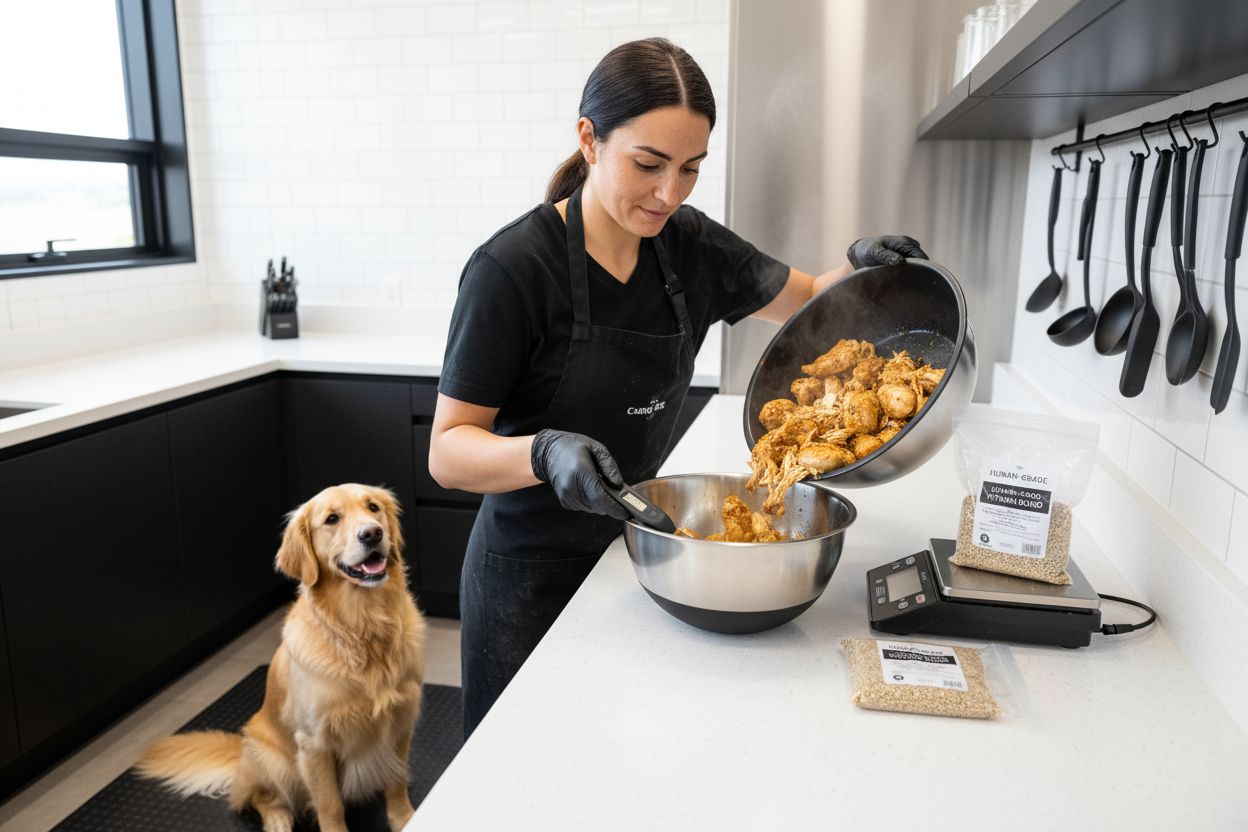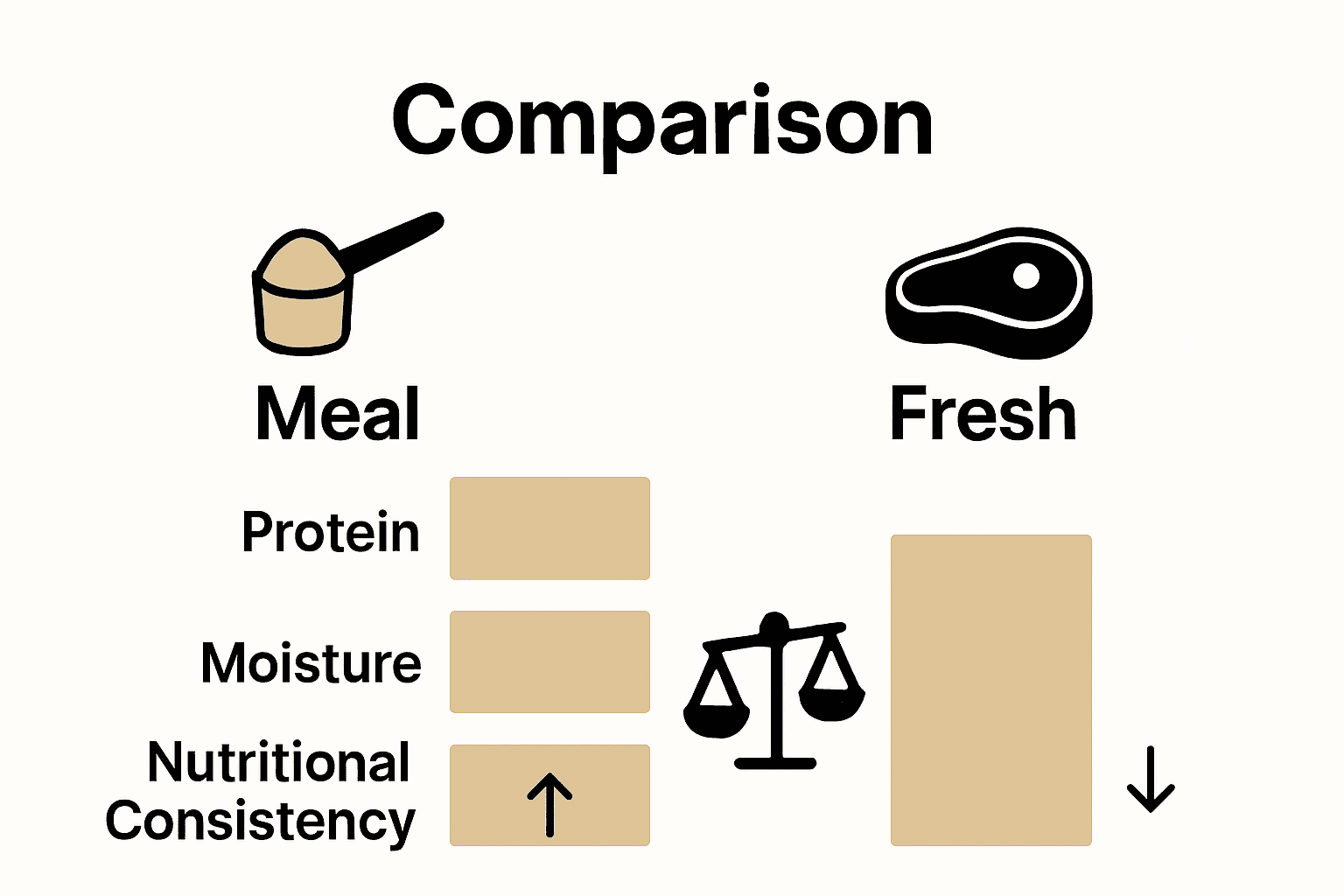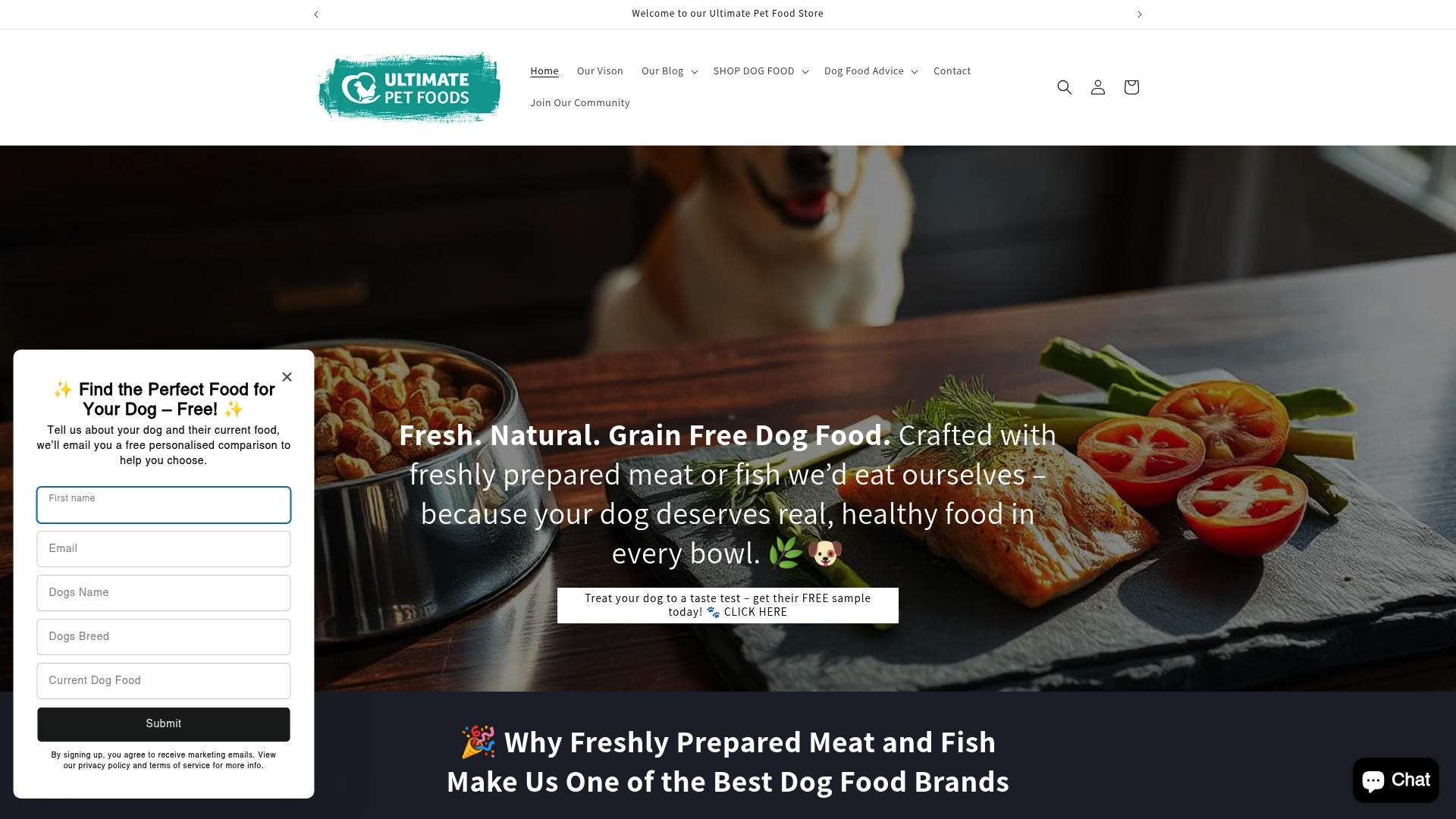
Complete Guide to Meal in Dog Food UK
Share
Did you know that some dog food meals contain up to 65 percent protein, making them one of the most concentrated sources of nutrients for pets? Many owners see the word ‘meal’ on ingredient labels and wonder what it really means for their dog’s health. Understanding these terms can help you choose food that delivers quality nutrition, supports muscle development, and keeps your dog energetic and happy every day.
Key Takeaways
| Point | Details |
|---|---|
| Understanding Meal | Meal in dog food is a concentrated protein source derived from animal ingredients, processed to enhance nutrient density. |
| Nutritional Benefits | Meal ingredients provide higher protein concentrations and essential nutrients compared to fresh meat, supporting better canine health. |
| Ingredient Transparency | Strict regulations ensure clarity in ingredient sourcing and labeling, allowing pet owners to make informed decisions about their dog’s nutrition. |
| Balanced Nutrition Approach | Combining meal and fresh ingredients offers a comprehensive nutritional profile that meets the dietary needs of dogs effectively. |
Table of Contents
- Defining Meal In Dog Food Products
- Types Of Meal Used In Dog Food
- Nutritional Function Of Meal Ingredients
- UK Regulations And Sourcing Standards
- Risks, Benefits, And Common Misconceptions
- Comparing Meal With Fresh Ingredients
Defining Meal in Dog Food Products
When exploring dog nutrition, the term “meal” often appears on ingredient labels, yet many pet owners remain uncertain about its precise meaning. According to research from Pets Radar, meal represents a specific protein processing method that transforms animal ingredients into a concentrated, nutrient-dense powder.
What Exactly is Meat Meal?
A meat meal is not simply ground-up meat, but a carefully processed protein source that undergoes specific preparation techniques. The process involves:
- Drying the protein source
- Heat-treating to eliminate potential pathogens
- Grinding into a fine, uniform powder
- Removing undesirable components like hair, feathers, and internal organ contents
This processing method creates a protein concentrate that offers several nutritional advantages. Meal ingredients provide a more condensed source of protein compared to whole meat, which contains significant water weight. For dog owners seeking nutrient-rich feeding options, understanding meal composition becomes crucial.
Our specially prepared kibble contains freshly prepared meat or fish, gently cooked at 82°C to lock in nutrients and freshness. We use human-grade ingredients and include prebiotics MOS and FOS, ensuring your furry companion receives a balanced, high-quality meal that supports overall health and vitality. The meal preparation method allows us to create a nutritionally complete food that maintains protein integrity while removing unnecessary components.

Types of Meal Used in Dog Food
In the world of dog nutrition, several distinct protein meal types play crucial roles in formulating balanced diets. Understanding these meal variations helps pet owners make informed feeding decisions.
Chicken Meal
According to Wikipedia’s research, chicken meal represents a concentrated protein source comprised of clean chicken flesh and skin. Key characteristics include:
- Moisture content around 10%
- Protein concentration approximately 65%
- Fat content around 12%
- Excludes feathers, heads, feet, and internal organs
This concentrated form provides dogs with a dense, nutrient-rich protein source that supports muscle development and overall health.
Meat and Bone Meal
Here’s a comparison of the main meal types used in dog food:
| Feature | Chicken Meal | Meat and Bone Meal (MBM) |
|---|---|---|
| Protein Content | ~65% | 48-52% |
| Fat Content | ~12% | 8-12% |
| Ash Content | Low | 33-35% |
| Moisture/Water Content | ~10% | 4-7% |
| Composition | Clean flesh & skin No feathers, heads, feet |
Mixed muscle & bone |
Meat and bone meal (MBM) offers another protein variant used in pet nutrition. According to research, MBM typically contains:
- Protein levels between 48-52%
- Ash content of 33-35%
- Fat percentage ranging from 8-12%
- Water content of 4-7%
While still utilized in some European pet food formulations, our approach prioritizes freshly prepared meat or fish gently cooked at 82°C to lock in nutrients. We include human-grade ingredients and prebiotics MOS and FOS, ensuring a superior nutritional profile that supports your dog’s optimal health and vitality.
Nutritional Function of Meal Ingredients
Meal ingredients play a critical role in delivering concentrated nutrition to dogs, offering more than just basic sustenance. According to research from All About Dog Food, meat meals provide a significantly higher protein content by weight compared to fresh meat due to their dehydrated nature.
Protein Concentration Benefits
Protein meals deliver substantial nutritional advantages for canine health. Understanding single protein sources becomes crucial in comprehending their impact. Key nutritional functions include:
- Stabilising blood sugar levels
- Supporting lean muscle mass development
- Enhancing food palatability
- Providing concentrated nutrient delivery
Analytical Nutritional Assessment
As highlighted by Vets Kitchen, the analytical constituents list and ingredient ordering help assess protein quality. Our approach goes beyond standard formulations by gently cooking proteins at 82°C to preserve nutritional integrity. We use human-grade ingredients and include prebiotics MOS and FOS, ensuring a comprehensive nutritional profile that supports your dog’s overall health and vitality.
By focusing on high-quality meal ingredients, we create a nutritionally dense food that meets the complex dietary requirements of dogs across different life stages and breed sizes.
UK Regulations and Sourcing Standards
Navigation of pet food regulations requires careful understanding, especially when it comes to ingredient sourcing and labelling. According to UK Pet Food industry guidelines, pet food labelling must adhere to strict statutory requirements ensuring transparency and accuracy.
Ingredient Labelling Requirements
The UK maintains rigorous standards for pet food packaging and ingredient declaration. Key regulatory aspects include:
- Ingredients must be listed truthfully
- Packaging cannot be misleading
- Ingredients can be listed individually or in broader categories
- Percentage declarations are mandatory when specific ingredients are highlighted
Quality and Sourcing Protocols
Exploring ingredient standards reveals the complexity of pet nutrition regulations. Our commitment goes beyond minimum requirements by:
- Using human-grade ingredients
- Gently cooking proteins at 82°C to preserve nutritional integrity
- Including prebiotics MOS and FOS
- Ensuring transparent ingredient sourcing
By prioritizing high-quality, scientifically formulated nutrition, we deliver dog food that meets the most stringent UK regulatory standards while providing optimal health support for your furry companion.
Risks, Benefits, and Common Misconceptions
Meat meals often suffer from unwarranted misconceptions about their nutritional value. According to The Canine Code, many pet owners misunderstand the nutritional potential of processed protein sources.
Debunking Common Myths
Several persistent myths surround meat meal ingredients in dog nutrition:
- Meat meals are NOT inferior to whole meat
- Processed meals can be higher in protein concentration
- Animal derivatives often provide essential nutrients
- Regulatory standards ensure removal of harmful components
Transparency in Ingredient Sourcing
Understanding ingredient quality is crucial for informed pet nutrition. As highlighted by All About Dog Food, while “meat and animal derivatives” labelling might seem vague, it doesn’t necessarily indicate unsafe ingredients.
Our commitment transcends standard practices. We gently cook proteins at 82°C to preserve nutritional integrity, use human-grade ingredients, and include prebiotics MOS and FOS. By prioritizing transparency and quality, we ensure your dog receives a nutritionally complete meal that challenges misconceptions about processed pet food.
Comparing Meal with Fresh Ingredients
Protein sources in dog nutrition represent a complex landscape of nutritional options. According to Pets Radar, meal ingredients provide remarkable consistency that fresh meats cannot always guarantee.
Nutritional Density Comparison
Key differences between meal and fresh ingredients include:
- Meal offers concentrated protein content
- Fresh meat provides higher moisture levels
- Meal ensures uniform nutritional profile
- Fresh ingredients enhance palatability
Balanced Nutritional Approach
Understanding the benefits of fresh dog food reveals the importance of strategic ingredient selection. As highlighted by Vets Kitchen, optimal nutrition emerges from carefully balancing meal and fresh ingredients to maximize essential amino acid and fat availability.
Our approach transcends traditional formulations by gently cooking proteins at 82°C to preserve nutritional integrity. We combine human-grade ingredients with prebiotics MOS and FOS, creating a scientifically balanced meal that delivers consistent nutrition while maintaining the palatability dogs love. This method ensures your furry companion receives a comprehensive nutritional profile that supports overall health and vitality.

Does Your Dog’s Food Meet UK Meal Standards?
Choosing the right food for your dog can feel overwhelming, especially after learning about protein meal types and how quality ingredients affect your dog’s health and wellbeing. Many owners, just like you, worry about transparency, ingredient sourcing, and whether meals used in commercial foods provide genuine nutritional value. Our carefully selected salmon dog food range uses fresh, hypoallergenic ingredients and avoids vague meals or animal derivatives, aligning with the clear definitions discussed in our Complete Guide to Meal in Dog Food UK.

Give your dog the confidence of a balanced, expertly formulated meal that supports digestion, skin health, and optimal energy. Start exploring our full selection at Ultimate Pet Foods, or browse all healthy dog food collections now. See the difference that premium, grain-free nutrition can make and make your dog’s next meal their healthiest one yet.
Frequently Asked Questions
What does ‘meal’ mean in dog food?
‘Meal’ in dog food refers to a concentrated protein source derived from animal ingredients that have been dehydrated, heat-treated, and ground into a fine powder, providing higher protein content than fresh meat by weight.
How is meat meal processed?
Meat meal is processed by drying the protein source, heat-treating it to eliminate pathogens, grinding it into a powder, and removing undesirable components like hair and feathers, resulting in a nutrient-dense product.
What are the benefits of using meal ingredients in dog food?
Meal ingredients offer concentrated nutrition, higher protein density, and improved palatability, while also stabilizing blood sugar levels and supporting muscle development in dogs.
How does chicken meal compare to meat and bone meal?
Chicken meal has a protein content of around 65% with low ash content, while meat and bone meal has protein levels between 48-52% with a higher ash content of 33-35%, which affects their nutritional profiles in dog food.
